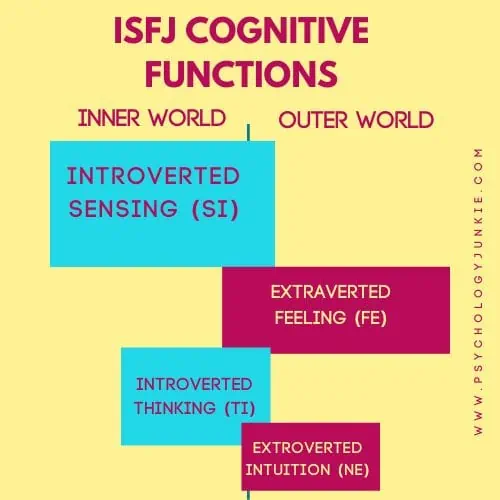The ISFJ Si-Ti Loop Explained
Ever find yourself locked in an endless loop of overanalyzing every conversation you’ve ever had, while simultaneously retreating from actual human interaction? Do you catch yourself nitpicking tiny details—like whether that text you sent was too enthusiastic (was the smiley emoji overkill?)—but then struggle to articulate how you actually feel about anything? Do you feel like you’re stuck in a rut, convinced that if you just think hard enough, you’ll figure out how to feel better?
Welcome to the Si-Ti loop, an unfortunate little mental trap where ISFJs get stuck cycling between Introverted Sensing (Si) and Introverted Thinking (Ti)—and in the process, slowly detach from the warm, empathetic, and socially attuned side of themselves. Instead of checking in with their values and emotional world through Extraverted Feeling (Fe), they bury themselves in memories, logic, and self-isolation.

It’s like trying to solve an emotional problem with a math equation—you can try, but good luck making it work.
If you’re an ISFJ and you feel like you’re stuck in your head, obsessing over every past mistake while simultaneously being hyper-critical of the world around you, there’s a good chance you’re in a Si-Ti loop. Let’s break it down.
The Cognitive Functions of the ISFJ

You’ve got four main cognitive functions that shape the way you process the world:
- Dominant Function: Introverted Sensing (Si) – Your personal database of experiences. Si catalogs everything that’s ever happened to you, then cross-references the past with the present. It craves stability, routine, and familiarity—like a cozy, well-worn sweater that you refuse to part with, even if it’s covered in coffee stains.
- Auxiliary Function: Extraverted Feeling (Fe) – The part of you that needs connection. Fe helps you read social cues, respond to emotions, and create harmony in relationships. It’s the function that makes you the go-to person for emotional support—but also the one that vanishes when you’re deep in a Si-Ti loop.
- Tertiary Function: Introverted Thinking (Ti) – Your inner detective. Ti is precise, logical, and analytical. It’s great for problem-solving, but when overused, it turns into a relentless self-critic that overanalyzes everything until you spiral into indecision.
- Inferior Function: Extraverted Intuition (Ne) – The wild card. Ne pushes you to explore new ideas, take risks, and see alternative possibilities. It’s weak but important, like that one flaky friend who occasionally drags you out of your comfort zone (but is usually too busy to show up).
When ISFJs are mentally balanced, these functions work together like a well-rehearsed orchestra—Si keeps you grounded, Fe keeps you connected, Ti helps you think critically, and Ne adds just enough curiosity to keep life interesting.
But when you’re in a Si-Ti loop? Fe and Ne get shoved into a dark basement while Si and Ti take over the controls. The result? Overthinking, perfectionism, emotional detachment, and a slow-but-steady retreat into your own mind.
If that sounds familiar, don’t worry—we’ll get you out of this mental maze. But first, let’s talk about what being stuck in a Si-Ti loop actually feels like.
What Happens in a Si-Ti Loop?

Imagine your brain is running a software program designed to keep you safe, supported, and reasonable—but there’s a glitch. Instead of a smooth, well-balanced system, you’re stuck in an endless feedback loop where two introverted processes (Si and Ti) take turns reinforcing each other. And whenever you’re stuck in an introverted loop, you stop getting balance from the world around you. The world of relationships, experiences, and interaction.
- Introverted Sensing (Si) starts by pulling up a mental archive of past experiences, scanning for patterns, and replaying old situations like a never-ending highlight reel. Normally, this function helps you feel grounded and secure, but in a loop, it becomes obsessive and risk-averse. It whispers, “Stick to what you know. Don’t take any chances. Change is dangerous.”
- Introverted Thinking (Ti) then jumps in, dissecting those past experiences like a scientist in a lab, searching for answers, logic, and flaws. Usually, Ti helps you think critically and make smart decisions, but in a loop, it turns against you. Instead of problem-solving, it starts overanalyzing, nitpicking, and doubting everything—including your own choices, memories, and emotions.
Together, these two functions create a mental vortex where you keep replaying the past, critiquing your own logic, and trying to think your way out of feelings—while slowly losing touch with the real world.
This loop makes you feel like you’re trapped in your own head, picking apart every detail of life without actually living it. It’s like watching your life play out through a security camera instead of stepping outside and experiencing it for yourself.
Signs You’re in a Si-Ti Loop
So, how do you know if you’re stuck? Here are some classic warning signs that Si and Ti have taken over the driver’s seat:
✅ You retreat excessively from the outside world.
People? Too unpredictable. Socializing? Too draining. You’d rather stay in your safe, predictable space, even if it means feeling isolated.
✅ You become cold, distant, or overly critical toward others.
You’re usually warm and supportive, but in a loop, you might find yourself withdrawing emotionally, nitpicking flaws, or struggling to relate to people’s feelings.
✅ You overanalyze past experiences and struggle to move on.
Your mind keeps replaying old mistakes, trying to “figure out what went wrong”—but instead of gaining insight, you just end up stuck in regret or self-doubt.
✅ You struggle to articulate emotions or explain personal choices.
When someone asks how you’re feeling, you might go blank. Feeling? What even is that? Instead of sharing what’s on your mind, you retreat into silence or analysis-paralysis.
✅ You fixate on technicalities or nitpick others’ logic.
Suddenly, every conversation feels like a debate to be won, and you find yourself correcting tiny details or pointing out flaws in people’s reasoning instead of connecting with them.
✅ You seek to prove intelligence by debating or “one-upping” others.
Your Ti is working overtime, making you hyper-aware of flaws in logic, inconsistencies, or errors—and instead of letting things go, you feel compelled to correct or outthink the people around you.
✅ Perfectionism takes over, making you avoid tasks out of fear of doing them “wrong.”
You want everything to be just right—but instead of starting, you procrastinate, convinced that you don’t have enough information or skill yet.
✅ You overthink without taking action.
You analyze, strategize, and plan…but never actually do anything. Every decision feels like it has too many risks, so you keep researching, refining, and delaying.
✅ You become self-protective and defensive, avoiding vulnerability.
Opening up feels risky, so you keep your thoughts and feelings locked inside. If someone challenges you, you might double down on your logic instead of admitting uncertainty or emotion.
The Dangers of Staying in a Si-Ti Loop
A Si-Ti loop might feel safe—after all, you’re just trying to be logical, cautious, and stick with what you know—but in reality, it’s like living in a fortress where the doors are locked from the inside. The longer you stay in this loop, the more disconnected, rigid, and critical you become. Here’s why staying stuck in this mode can be a slow descent into emotional isolation:
Emotional Disconnect
Your Extraverted Feeling (Fe)—the part of you that craves connection—gets completely sidelined. You might start feeling like emotions are an inconvenience, or worse, irrelevant. Instead of sharing your feelings, you might default to keeping everything inside, rationalizing your emotions away (“It doesn’t make logical sense to feel this way, so I’ll just ignore it”). The problem? Emotions don’t disappear just because you refuse to acknowledge them—they pile up, simmer under the surface, and can eventually manifest as stress, resentment, passive-aggressiveness, or even burnout.
Rigidity & Isolation
Si and Ti together are like an overprotective older sibling and a cynical detective—they keep you stuck in what’s familiar and “proven”, making anything new feel unnecessary or even risky. The more you rely on them, the harder it is to step outside your comfort zone and gain confidence. Socializing, trying new things, or even admitting you don’t have all the answers feels like a threat, so you retreat deeper into what feels “safe.” Over time, this leads to loneliness and stagnation—you might find yourself longing for connection but feeling too detached to reach out.
Unhealthy Overanalysis
Ti in a loop isn’t about good critical thinking—it’s about obsessive nitpicking. Instead of being open to new perspectives, you use your logic to rationalize your biases and past experiences, reinforcing negative thought patterns. You might find yourself running in mental circles, convinced that if you just think harder, you’ll solve whatever is making you unhappy. But here’s the thing: happiness isn’t an equation you can brute-force your way through. And you might find yourself rationalizing biases according to skewed, subjective data.
Social Criticism
In a loop, you might subconsciously push people away by becoming overly critical or dismissive. Conversations start to feel like debate competitions, and instead of connecting with others, you find yourself correcting their logic, pointing out flaws, or struggling to empathize. It’s not that you don’t care—you do, deeply—but your Fe is offline, so you’re operating on detached reasoning instead of emotional understanding. The result? People may feel like they’re “walking on eggshells” around you, further deepening your sense of isolation.
How to Break Out of a Si-Ti Loop
So, how do you get unstuck? The key is to re-engage with your extraverted functions—Extraverted Feeling (Fe) to reconnect with people and Extraverted Intuition (Ne) to introduce flexibility and new possibilities.
Engaging Fe (Extraverted Feeling) – Reconnecting with People
Your Fe is like a neglected garden—at first, it might feel unnatural to use it again, but with care, it will bloom back to life. Here’s how:
✔ Reach out to others. Talk to someone you trust about how you’re feeling, even if you don’t have the “perfect” words. Just saying things out loud can help break the loop.
✔ Practice random acts of kindness. Send a thoughtful message, surprise a friend with coffee, volunteer for a cause. When you focus on someone outside of yourself, it shifts your perspective.
✔ Engage in meaningful conversations. Instead of debating logic, ask people about their experiences and emotions. Listen without analyzing—just take it in.
✔ Express your emotions. If talking feels too vulnerable, try journaling or recording a voice note. Don’t overanalyze what you’re writing—just let it flow.
✔ Watch a movie that pulls on your heartstrings. Simply opening yourself up to your emotions and to the stories and experiences of other people can help you to get back in touch with your empathy.
Activating Ne (Extraverted Intuition) – Embracing New Possibilities
Your inferior Ne may be quiet, but it’s your lifeline to growth and spontaneity. If Si-Ti is your mental fortress, Ne is the window that lets fresh air in.
✔ Challenge your assumptions. Ask yourself:
- What if I tried something different?
- Is there another way to see this situation?
- What’s the worst that could happen if I took a small risk?
✔ Expose yourself to new experiences. Watch a documentary on a topic you’ve never considered. Read a book from a totally different perspective. Talk to someone with opposing opinions and actually listen.
✔ Step outside your comfort zone. Take a small risk. It doesn’t have to be drastic—try a new food, start a conversation with a stranger, change up your daily routine. Each tiny shift helps shake off the rigidity of the loop.
✔ Allow for imperfection. Ne thrives on experimentation, not perfection. Remind yourself that you don’t have to know everything before you start. Some of the best experiences come from uncertainty and improvisation.
What Has Your Experience Been?
If you’ve been trapped in a Si-Ti loop, I get it—it feels safe. But in reality, it’s like trying to drive through life by only looking in the rearview mirror and dissecting the GPS coordinates. You’re not actually living—you’re just running calculations.
The good news? You don’t have to stay stuck. Reconnecting with Fe will bring warmth and depth back to your relationships, while Ne will open up the world in exciting, unexpected ways.
So take a deep breath. Reach out to someone. Do something spontaneous. Your world doesn’t have to be a closed loop—it can be an open door. 🚪💛(queue Frozen soundtrack).
30-Day Personal Growth Challenge for ISFJs
The Two Sides of the ISFJ Personality Type
10 Things You Crave Every Day as an ISFJ Personality Type
24 Signs That You’re an ISFJ, the “Protector” Personality Type
A Look at the ISFJ Leader
10 Characteristics of the ISFJ Child


















